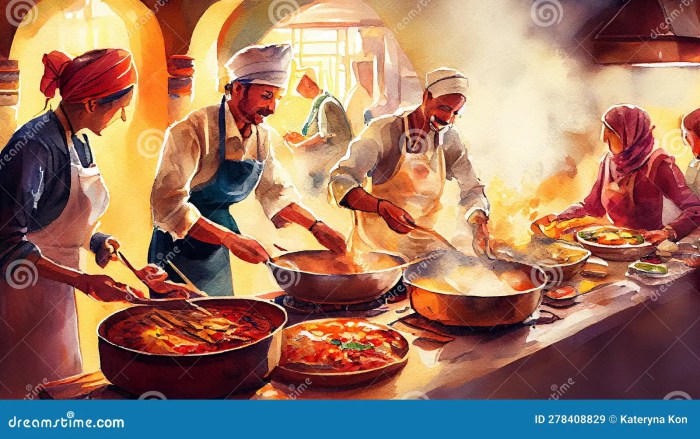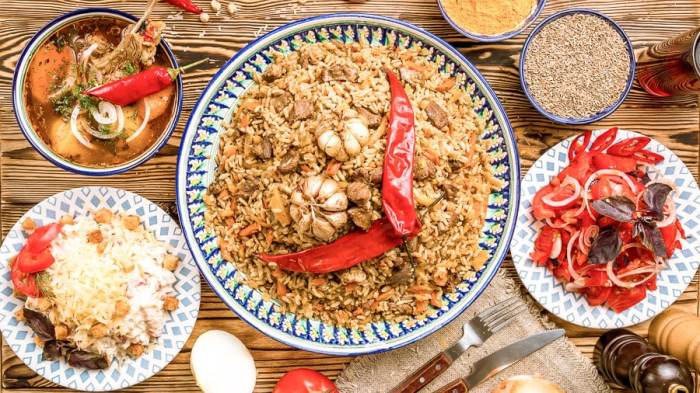
Culinary Heritage and Cultural Identity

Exploring ethnic culinary traditions – Ethnic culinary traditions are deeply intertwined with cultural identity, serving as a tangible manifestation of a people’s history, values, and beliefs. Food customs and practices shape cultural norms and provide insights into the collective experiences and aspirations of a community.
Preservation and Transmission of Cultural Heritage
Food plays a crucial role in preserving and transmitting cultural heritage. Traditional dishes, cooking techniques, and ingredients are often passed down through generations, embodying the wisdom and skills of ancestors. By preparing and consuming these foods, individuals connect with their cultural roots and maintain a sense of continuity with the past.
Examples of Culinary Traditions Shaping Cultural Identity
- In many Asian cultures, rice is a staple food that symbolizes prosperity, fertility, and life. The act of sharing rice symbolizes community and unity.
- In Mexico, the traditional Day of the Dead celebration includes preparing and offering food to deceased loved ones, honoring their memory and maintaining a connection with the afterlife.
- In Ethiopia, the communal coffee ceremony is a ritual that fosters social bonding, hospitality, and cultural exchange.
Ingredients and Techniques: Exploring Ethnic Culinary Traditions

Delve into the realm of ethnic cuisines, where unique ingredients and masterful techniques weave a tapestry of distinctive flavors and textures. From the vibrant spices of the East to the hearty comfort foods of the West, each culinary tradition holds a treasure trove of secrets that define its identity.
The ingredients employed in ethnic cuisines are often a reflection of the local environment and cultural influences. In Southeast Asia, for instance, tropical fruits like mangoes, coconuts, and tamarind lend their sweet and tangy notes to dishes, while in the Mediterranean, aromatic herbs such as basil, oregano, and thyme infuse foods with their herbaceous fragrance.
Key Ingredients and Techniques in Ethnic Cuisines, Exploring ethnic culinary traditions
| Cuisine | Key Ingredients | Cooking Techniques |
|---|---|---|
| Chinese | Soy sauce, rice wine, ginger, garlic | Stir-frying, steaming, braising |
| Indian | Spices (turmeric, cumin, coriander), lentils, yogurt | Tandoori grilling, curries, simmering |
| Mexican | Corn, beans, chiles, tortillas | Grilling, roasting, simmering |
| Italian | Tomatoes, basil, olive oil, pasta | Pasta-making, sauces, baking |
| French | Butter, cream, wine, cheese | Pan-frying, sauces, baking |
The cooking techniques employed in ethnic cuisines are equally diverse, ranging from the delicate art of sushi-making in Japan to the slow-cooked stews of Morocco. In many Asian cuisines, wok-frying is a staple technique, allowing for quick and flavorful cooking. In the Middle East, grilling is a popular method, imparting a smoky and charred flavor to meats and vegetables.
These ingredients and techniques come together to create a symphony of flavors and textures that define the character of each ethnic cuisine. They are a testament to the creativity and cultural heritage of the people who have shaped them, and they continue to inspire and delight diners around the world.
Social and Communal Aspects of Food
Food plays a vital role in fostering social connections and strengthening community bonds within ethnic cultures. It serves as a catalyst for gatherings, celebrations, and commemorations, reinforcing a sense of shared identity and belonging.
Communal meals are a cornerstone of many ethnic traditions. Families and communities gather around the table to share meals, exchanging stories, laughter, and traditions. These shared experiences create a sense of togetherness and belonging, passing down cultural values and practices from one generation to the next.
Food-Related Events
Food-related events are central to ethnic communities. Festivals, holidays, and other special occasions are often marked by unique culinary traditions. These events provide opportunities for community members to come together, celebrate their shared heritage, and strengthen their cultural identity.
- Celebrations: Food plays a central role in many celebrations, such as weddings, birthdays, and religious festivals. Special dishes are prepared, symbolizing joy, prosperity, and good fortune.
- Commemorations: Food is also used to commemorate significant events and honor ancestors. Memorial meals and traditional dishes are shared to pay tribute to loved ones and preserve cultural memories.
- Strengthening Community Bonds: Food-related events serve as a platform for community members to connect, socialize, and reinforce their cultural bonds. They foster a sense of unity and belonging, creating a strong and vibrant community.
Preserving and Promoting Culinary Traditions
Ethnic culinary traditions are an integral part of cultural identity and heritage. Preserving and promoting these traditions is crucial to ensure their continuity and to foster cultural diversity. However, it faces challenges and presents opportunities.
Challenges
- Globalization and Homogenization: Globalized food systems and mass-produced food items threaten the diversity and uniqueness of ethnic cuisines.
- Urbanization and Migration: Population shifts can disrupt traditional food practices and lead to the loss of culinary knowledge and skills.
- Lack of Documentation: Many ethnic culinary traditions are passed down orally, making them vulnerable to being forgotten or distorted.
Opportunities
- Cultural Tourism: Culinary traditions can be a valuable asset for tourism, promoting cultural exchange and economic development.
- Educational Initiatives: Schools, universities, and community organizations can incorporate ethnic culinary traditions into their curricula, fostering appreciation and understanding.
- Community Involvement: Local communities play a vital role in preserving traditions through cooking classes, festivals, and other cultural events.
Best Practices for Preserving and Promoting Culinary Traditions
| Aspect | Best Practices |
|---|---|
| Documentation | – Create written recipes, record cooking techniques, and interview elders to preserve knowledge. – Establish databases and archives to store and share culinary information. |
| Education | – Integrate ethnic culinary traditions into school curricula, workshops, and cooking classes. – Train chefs and food professionals to promote traditional cuisines. |
| Community Involvement | – Host community cooking events, festivals, and markets to celebrate and share culinary traditions. – Establish community gardens and farms to support local food production. |